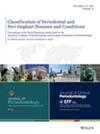Efficacy of soft tissue augmentation in the maxillary esthetic region: A 5-year randomized controlled trial.
IF 3.8
2区 医学
Q1 DENTISTRY, ORAL SURGERY & MEDICINE
引用次数: 0
Abstract
BACKGROUND Soft tissue grafting at dental implant sites has been proposed to enhance esthetic outcomes. A xenogeneic collagen matrix (XCM) was introduced as an alternative grafting material to connective tissue. Only short-term results are yet available. METHODS Sixty patients were treated in a randomized controlled trial with a connective tissue graft (n = 20, CTG group), an XCM (n = 20, XCM group), or received no graft (n = 20, NG group). The grafts were placed at the time of implant placement in a preserved alveolar ridge. The primary outcome was a change in mid-buccal mucosal level (MBML) after 5 years (T60). Secondary outcomes were marginal bone level, clinical peri-implant parameters, esthetics, and patient satisfaction. RESULTS At T60, mean changes in MBML were -0.41 ± 1.20 mm, -0.30 ± 1.22 mm, and -0.61 ± 1.72 mm in the CTG, XCM, and NG groups (p = 0.78), respectively. Also, regarding the secondary outcome variables, no significant between-group differences were observed. CONCLUSIONS Soft tissue grafting at single implant placement after alveolar ridge preservation, either with a CTG or XCM, does not result in a better esthetic outcome and should not be considered as a standard procedure. PLAIN LANGUAGE SUMMARY Implant placement in case of a failing tooth is a favorable treatment option. However, since the extraction socket is often associated with a large bone defect, alveolar ridge preservation with bone grafts prior to implant placement is often needed. To compensate for possible soft tissue defects, the application of a CTG or an XCM has been proposed. The question has arisen whether the use of an XCM will give a better outcome than a CTG. Furthermore, are both soft tissue augmentation therapies accompanied by a better esthetic result than performing no soft tissue therapy at all? Therefore, a 5-year study was carried out in which 60 patients with a failing tooth in the frontal region of the upper jaw were treated with removal of the tooth and restoring the gap with bone graft and sealing the socket with mucosagraft from the tuberosity region. At the time of implant placement 5 months thereafter, 20 patients received a CTG, 20 patients received an XCM, and 20 patients no soft tissue therapy. After 5 years, it appeared that there was no difference between the 3 soft tissue treatment procedures. Thus, implant placement combined with soft tissue grafting in preserved alveolar ridges does not result in a better esthetic outcome.上颌美观区软组织隆胸的疗效:一项5年随机对照试验。
背景:植牙部位的软组织移植已被提出以提高美观效果。介绍了异种胶原基质(XCM)作为结缔组织移植的替代材料。目前只有短期的结果。方法60例患者分别接受结缔组织移植(n = 20, CTG组)、XCM组(n = 20, XCM组)和不接受移植(n = 20, NG组)的随机对照试验。移植物放置在保留的牙槽嵴内。主要结果是5年后(T60)中颊粘膜水平(MBML)的变化。次要结果是边缘骨水平、临床种植体周围参数、美学和患者满意度。结果T60时,CTG、XCM和NG组MBML的平均变化分别为-0.41±1.20 mm、-0.30±1.22 mm和-0.61±1.72 mm (p = 0.78)。此外,关于次要结局变量,组间无显著差异。结论保留牙槽嵴后单种植体软组织移植,无论是CTG还是XCM,都不能获得更好的美观效果,不应作为标准手术。在牙齿脱落的情况下植入种植体是一种良好的治疗选择。然而,由于拔牙窝通常伴有较大的骨缺损,因此通常需要在植入种植体之前用骨移植物保存牙槽嵴。为了弥补可能的软组织缺陷,已经提出了CTG或XCM的应用。问题是,使用XCM是否会比CTG产生更好的结果。此外,两种软组织增强疗法是否都比完全不进行软组织治疗有更好的审美效果?因此,我们进行了一项为期5年的研究,对60例上颌额区失植牙患者进行了拔除牙齿,植骨修复间隙,并用结节区粘膜夹板封闭牙槽的治疗。5个月后植入时,20例患者接受CTG治疗,20例患者接受XCM治疗,20例患者未接受软组织治疗。5年后,3种软组织治疗方法之间似乎没有差异。因此,在保留牙槽嵴中植入种植体并结合软组织移植并不能获得更好的美观效果。
本文章由计算机程序翻译,如有差异,请以英文原文为准。
求助全文
约1分钟内获得全文
求助全文
来源期刊

Journal of periodontology
医学-牙科与口腔外科
CiteScore
9.10
自引率
7.00%
发文量
290
审稿时长
3-8 weeks
期刊介绍:
The Journal of Periodontology publishes articles relevant to the science and practice of periodontics and related areas.
 求助内容:
求助内容: 应助结果提醒方式:
应助结果提醒方式:


